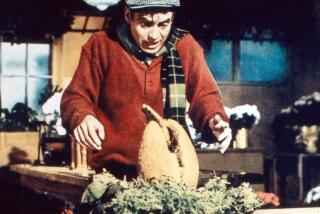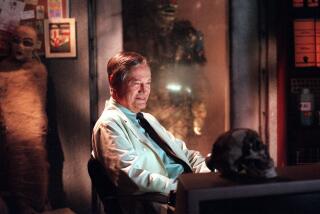The Envelope: Ronald Colman’s ‘Double Life’ role carries echoes of ‘Birdman’ theme
- Share via
As Michael Keaton’s critically lauded “Birdman” emerges as an Oscar hopeful, with its tortured actor losing sight of where his character ends and how much realism to bring to the stage, it calls to mind 1930s and ‘40s actor Ronald Colman.
The dashing, debonair Colman had been a major star since the silent era, making women’s hearts flutter in his heroic, romantic roles in such films as 1935’s “A Tale of Two Cities,” 1937’s “The Prisoner of Zenda” and 1942’s “Random Harvest.”
Colman finally got a chance to show a darker side in 1947’s “A Double Life,” a psychological thriller/film noir about a famous Broadway actor, Anthony John, who takes Method acting to a whole new and ultimately murderous level. Anthony is carefree and charming when he’s doing a comedy but loses his grip on his sanity when he stars in Shakespeare’s “Othello.”
Nominated for four Academy Awards — including director for George Cukor and screenplay for Garson Kanin and his wife, Ruth Gordon — “A Double Life” won Oscars for Colman’s dazzling tour-de-force performance as Anthony and for Miklos Rosza’s haunting score.
“A Double Life” also stars Signe Hasso as Brita, Anthony’s ex-wife and costar who fears for her life; Edmond O’Brien as their friend Bill, whom Anthony believes is having an affair with Brita; and a young Shelley Winters as Pat, a poor waitress who makes the mistake of flirting with Anthony when he comes into her shabby Italian restaurant.
The film also marked the first time Cukor collaborated with Kanin and Gordon. The trio went on to do such classic films as the Katharine Hepburn/Spencer Tracy comedies “Adam’s Rib” (1949) and “Pat and Mike” (1952).
Cukor, who was one of MGM’s top directors, made “A Double Life” at Universal. “MGM in 1947 wasn’t ready for this type of dark material,” said film noir historian Alan K. Rode, an L.A.-based film programmer and author of “Charles McGraw: Biography of a Film Noir Tough Guy.” “Kanin and Ruth Gordon came from the theater and so did Cukor, so they really knew this whole milieu of the theater.”
------------
FOR THE RECORD:
In an earlier version of this story, film noir historian Alan K. Rode’s name was misspelled as Alan R. Rode.
------------
In fact, the film’s original title was “Imagination,” said Rode. “The entire movie is illusion against reality. It’s Ronald Colman becoming ‘Othello’ and the whole artifice of the theater and that society, transposed against the Shelley Winters character who is really down and out.”
Interestingly, Colman wasn’t the first choice to play Anthony. They wanted Laurence Olivier, but when he wasn’t available, they went to Colman, who was 56 and had made only two films in the past five years.
“Part of the pitch to Colman was ‘This can win you the Oscar,’” said Rode. “By 1947, Colman was a revered figure in Hollywood but had never won the Oscar.”
Still, Colman was nervous. He had started his career on the stage but had never felt comfortable doing Shakespeare. So they brought in Walter Hampden, an acclaimed stage actor who had starred in many Shakespeare plays on Broadway, including a revival of “Othello” in 1925, to coach him. Hampden also staged the “Othello” scenes, which were shot in sequence and separately from the rest of the film’s non-stage performance scenes.
“A Double Life” also benefited immensely from Milton Krasner’s atmospheric chiaroscuro photography that reflects Anthony’s inner turmoil and descent into madness.
Cukor and the Kanins didn’t let Colman down on their promise to get him an Oscar. “A Double Life” launched an Oscar-qualifying run on Christmas Day in Los Angeles in 1947 (and rolled out wider in early 1948). Cukor campaigned for the actor by hosting screenings for academy members, while Colman took out trade ads.
Colman, who also won the Golden Globe for “A Double Life,” made only three more features before his death in 1958, including a cameo in the 1956 Oscar-winning picture, “Around the World in 80 Days.”
Twitter: @mymackie
More to Read
From the Oscars to the Emmys.
Get the Envelope newsletter for exclusive awards season coverage, behind-the-scenes stories from the Envelope podcast and columnist Glenn Whipp’s must-read analysis.
You may occasionally receive promotional content from the Los Angeles Times.










